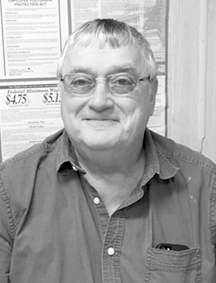
On the left side of Fruit Ridge and right before the intersection of Fruit Ridge and Cann and Brown road sitting on a bank in a mowed barn yard was a huge block building with a flat roof at least 30 feet high. The building itself was easily 40 x 50’ in size. Most guessed it to be a factory that was quietly operating there. Others guessed it must be a warehouse but didn’t know what was it used for and, more importantly, who owned it. The building was rectangular in shape and had large barn-like doors on the front and a regular door on one side for people to enter. To the left of that was a large garage connected and entry was from the left side into a section that could hold two or three autos. But the questions always returned as to what and whose it is.
The answer is interesting at least to me. In the late 30s there had been a wooden framed barn right where this building was. My cousin Walt Houser’s grandfather Bock owned the farm at that time. He was a contractor of notoriety in Cincinnati for his quality in his field. One evening he was held up and tied and robbed by two men and as they left they set his barn on fire and it burnt to the ground.
Now Mr. Bock being a builder decided to replace the barn but he saw its construction differently. I think first in his mind was he would build a barn that couldn’t be burnt. Second I have always heard he was going into the turkey business and a two story building complete with an elevator in it would be just what state of the art was at the time and he wanted to show all the neighbors that he was doing this project first class. First class it was and still is if the structure is studied closely.
However the farmers of the neighborhood just couldn’t see this project the same way. It wasn’t wood and they had never seen a barn with a second floor and plans for an elevator. Quite frankly Mr. Bock’s structure blew their minds! Since the late 1930s this barn has been on display to any and all who pass by it. By the way the turkey business never really got started and the elevator was never completed. But his one of a kind building after looking at it and seeing the obvious, that it is unique has had it pluses and minuses. With it constructed out of concrete block walls and all floors poured concrete and is held up by huge steel beams and steel columns that makes this building in a league of its own as far as strength. I know my dad used the driveway to work on tractors and equipment when weather was poor or the need for a solid floor and the beams could be of great assistance. There are large windows on all sides on both floors that allow a lot of light and allow those working inside the ability to see how their work was going.
The down side was when it was time to house the tobacco crop. The barn holds two tiers of rails to hang the tobacco on. One was on the first floor and the other on the second floor! (Top that all you story tellers about unusual barns!) Never before or since have I seen a two story barn. We would hang all the rails on the first floor and then when it was time to go upstairs we would get our wagon that was higher than the other, park it in the doorway and open a sliding door of good width on the second floor and place someone not afraid of heights in the doorway to receive the sticks of tobacco as the tallest man in the crew got the job to hand the sticks up to the second floor. (A sight we should have paid admission to watch as it was interesting to say the least.)
When things were slow and Tom wasn’t around, Walt and I would go up on the roof top and look out over the fields for what we thought was a distance too far to measure. But when Tom was around it seemed about every two years the barn got painted and Tom would change colors because he liked to keep things different. But most years it was green and on the front of this huge building was the name of the farm, ‘Green Acres’ of course. “To this day I have people ask me about that building on Fruit Ridge and since I grew up there did I know what that is? I tell them it is a barn and the first response is “yeah right, but what is it really?” Mr. Bock, you set the entire area on its ear when you built a city style barn out in the country.
Rick Houser grew up on a farm near Moscow in Clermont County and loves to tell stories about his youth and other topics, He may be reached at houser734@yahoo.com.
